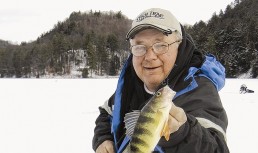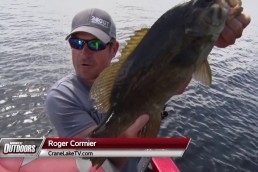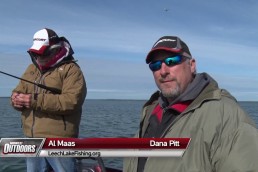Minnesota Makes Lake-hopping a Viable Strategy
SHARE THIS POST
Throughout the Midwest, we are blessed with good numbers of fishable waters. But Minnesota is special in that many people live within reasonable driving distance of many lakes that can produce good fishing on any given day.
Patience used to be thought of as a virtue among anglers, until the modern fishing revolution and the modern ice-fishing revolution. Nowadays, most savvy anglers don’t wait around for fish to decide to bite. They move on—continuously—until they find what they came for.
Dave Genz came to the rescue for all of us who want to actually fish through the ice, rather than head onto the ice with a multi-faceted social plan that includes plans B, C, and D, based on whether the fish are biting directly under where we choose to set up camp. The day became as likely to feature ice-skating, catch with a football, card games, and certain beverages, as it did the fishing. Genz taught us about mobility and fishing quickly, asking active fish to bite right away.
If they don’t, the Genz mandate says, “Go drill more holes in a different place.”
For most people, this is where ice-fishing mobility begins and ends. Hole-hopping is a time-honored strategy, but if we go back to Genz’s original declaration of mobility, he very much included lake-hopping in the discussion.
When another inviting lake is a half hour or less away (sometimes, in Minnesota, they’re across the street from each other), you can change your fortunes by tossing the gear back in the truck and spending a little windshield time to start over.
Lake-hopping as philosophy
By itself, the potential advantage of drilling holes on a totally different lake is significant. Nobody knows everything about why turkeys gobble with gusto on one farm and don’t say a thing on a farm 5 miles down the road; nobody knows everything about why the fish sit there with a sullen look on their faces in one lake, while they are chowing down in another lake 5 miles down the road. But these differences exist on any given day, and if there are multiple lake options in your immediate area, it becomes hard to sit there and get skunked.
One of my favorite fishing sayings of all time also comes from Genz, and he said it while talking about this exact concept: “How long does it take to catch nothing?”
Think about that. It can take as long as you decide to put up with it.
Following early ice
Among serious ice anglers, it’s known that first-ice and early-ice periods offer excellent fishing. If you live along the southern fringes of the Ice Belt, chances are you’re always enjoying early-ice conditions—given that the ice gets thick enough to fish, then a warm spell wipes the ice out entirely, then it comes back during another cold spell, and the cycle continues.
There’s a trick to staying on early-ice conditions for weeks, even in Minnesota. Start out on the first lakes to freeze up (shallow lakes, bays or arms of lakes and any wind-protected areas). Then, as cold temperatures stick around, deeper and more wind-exposed lakes develop safe ice, one after another.
Are you enjoying this post?
You can be among the first to get the latest info on where to go, what to use and how to use it!
Chisel in hand, walking carefully, wearing a life jacket, you can be among the first to get over top of fish that remain in that “gotta-eat-a-lot-because-lean-times-are-coming” mode.
Dave Genz, Rick Johnson, Pat Smith, and others among ice fishing’s elite do this, year after year. And if you’re a traveling ice angler with a truck and trailer that can haul gear down the highway, you can follow early ice in whatever direction it beckons, if you are so inclined.
Be careful out there, but don’t stay away. As Genz points out, public officials tell winter boaters to wear life jackets, and they tell ice anglers to stay off the ice. Wear a life jacket! Go with at least one other person. Stash a long and sturdy rope in your portable shelter where it’s instantly accessible. If somebody does go through, toss the rope and help them get back up on the ice, then go to your truck and get warm.
Walk onto early ice with a chisel in hand, striking the ice ahead of you. If you go through in two chops, turn around and walk back where you came from.
Staying on good bites
In the middle of an enduring Minnesota winter, fish that were catchable can become listless and almost impossible to tempt. The toll of weeks and months of ice and snow cover reduces dissolved oxygen in the water. As Genz first theorized, in severe winters, the warmest available water temperature can dip below 39 degrees, becoming a big factor in and of itself.
During these midwinter doldrums, to stay on the best available fishing action, target larger lakes. After smaller bodies of water have gone essentially dead, fishing-wise, good catches can still be made on more expansive lakes.
Clear and dark
Another way to stay on top of good fishing throughout the winter is to pay attention to water clarity. Water is never clearer than when under a coating of ice, because sediments settle to bottom, giving fish in every lake a better look at things.
But there are still differences—lake to lake—when it comes to clarity, and the best fishing times are usually predictable based on how clear the water is. On truly clear-water lakes, the best action tends to be concentrated during the rapidly changing light levels of early morning and “evening,” which is more accurately, late afternoon at this time of year.
On darker-water lakes, the best action can come in the middle of the day.
Now, imagine the possibilities if you can stay mobile enough to fish multiple lakes on the same day. Start out on a good clear-water lake as the sun is coming up in the morning. Then switch over to a darker-water lake for the midday bite. Then, head back to the clear-water lake (or even a different clear-water lake) for the prime time, sunset-driven bite.
There’s more to it than this, but if you set your gear up to be easily packed and unpacked and you stay light enough to drill and move while you’re on the ice, you can not only go from hole to hole, but from lake to lake, not giving in until you catch what you came for.
MWO
SHARE THIS POST
Did you enjoy this post?
You can be among the first to get the latest info on where to go, what to use and how to use it!
Mark Strand
MidWest Outdoors editorial director Mark Strand is a graduate of University of Minnesota School of Journalism with a minor in Fisheries & Wildlife Science. He has written for nearly every outdoor magazine over the past 41 years, and has written or co-written 14 books. In addition to writing and photography, Strand produces the MidWest Outdoors Podcast, and contributes to MWO digital properties. He is an outdoor generalist who loves hunting and fishing of all types. In 2018 Strand was elected to the Minnesota Fishing Hall of Fame.



